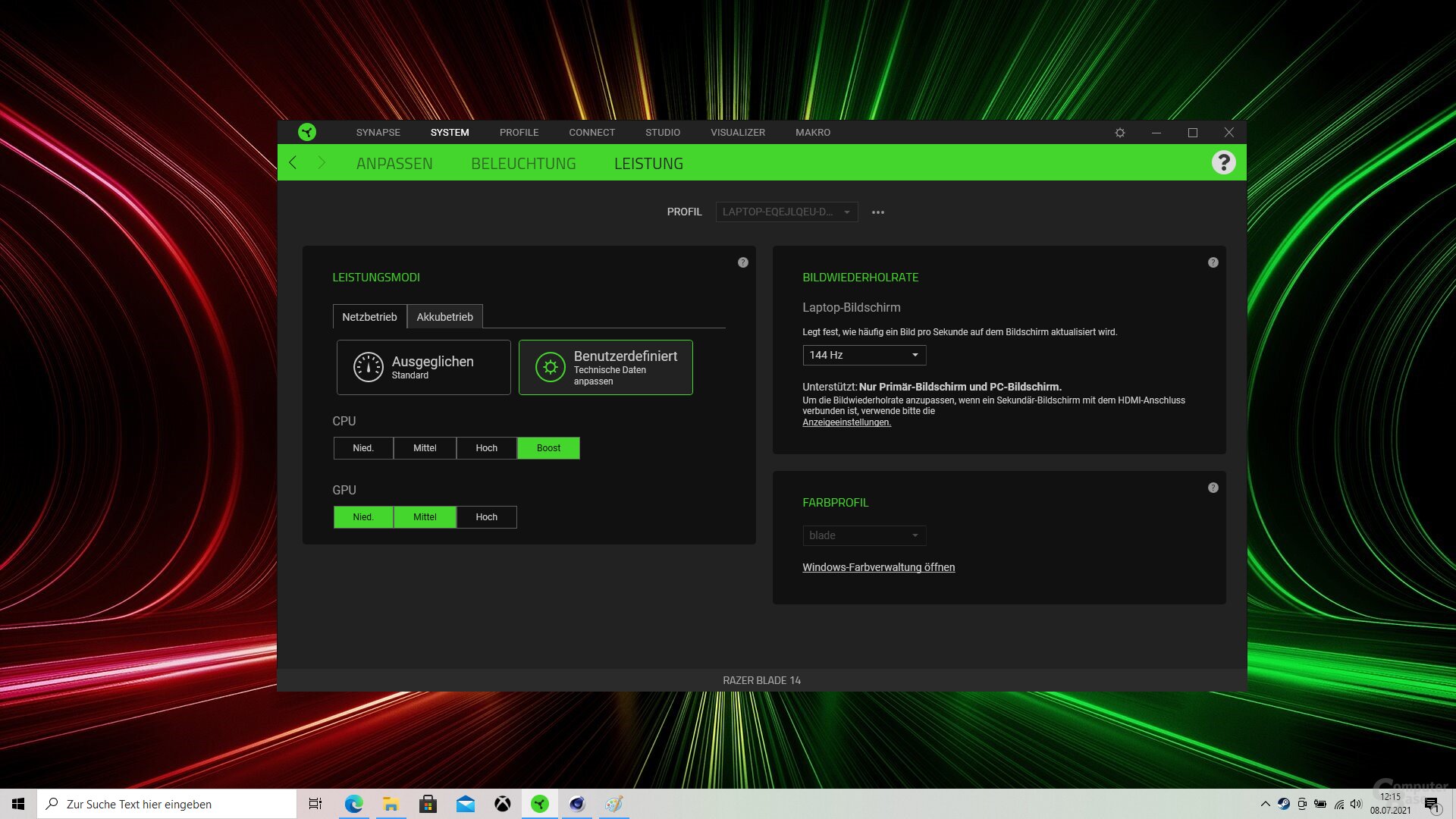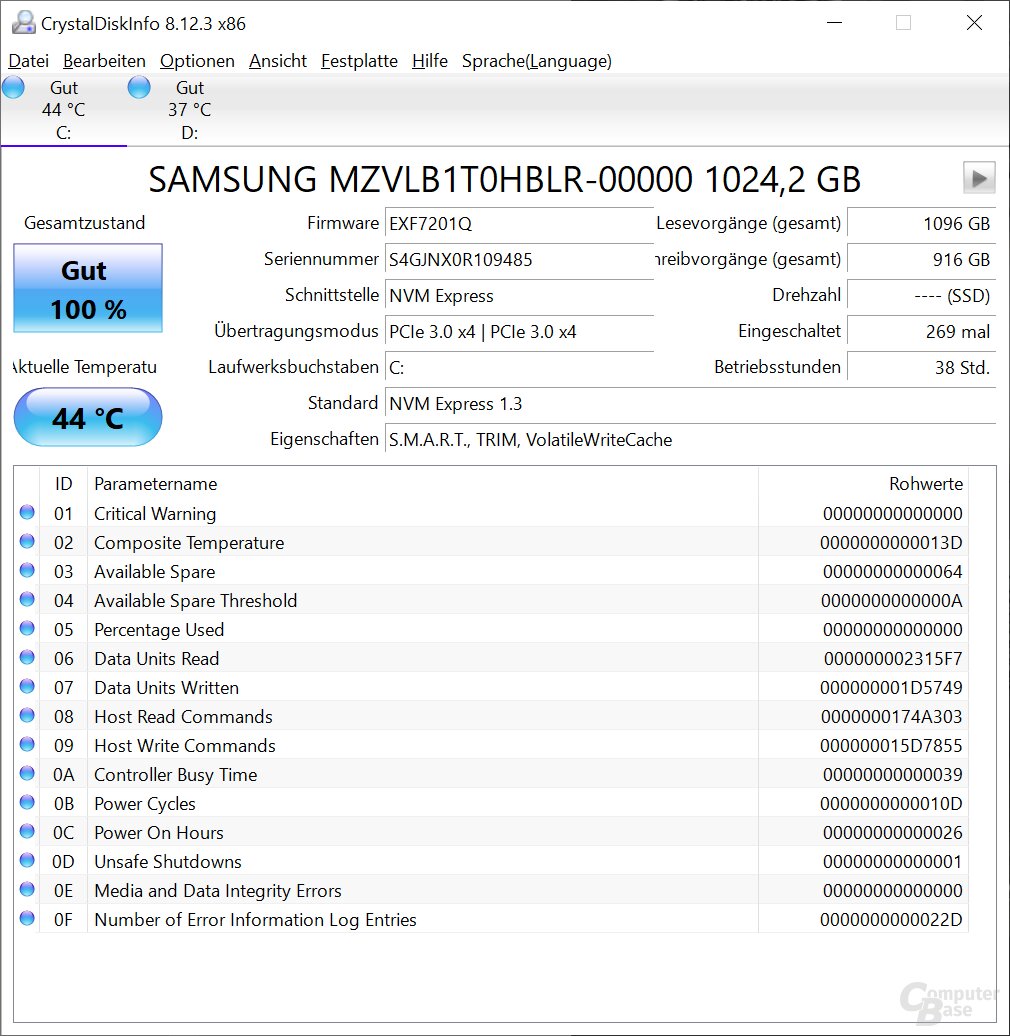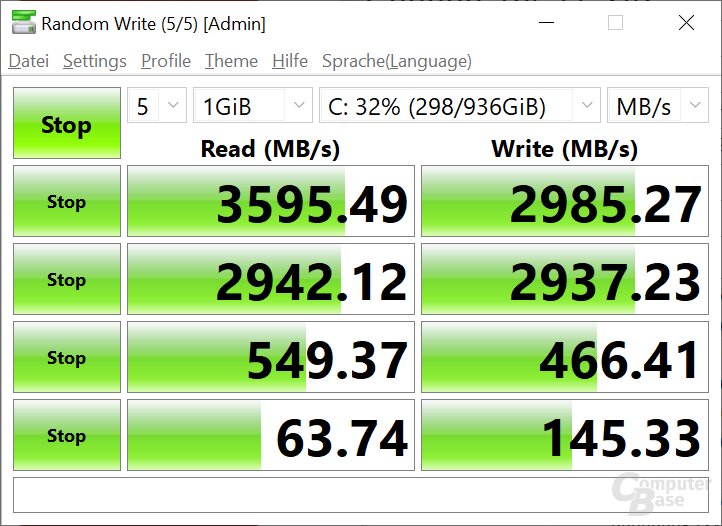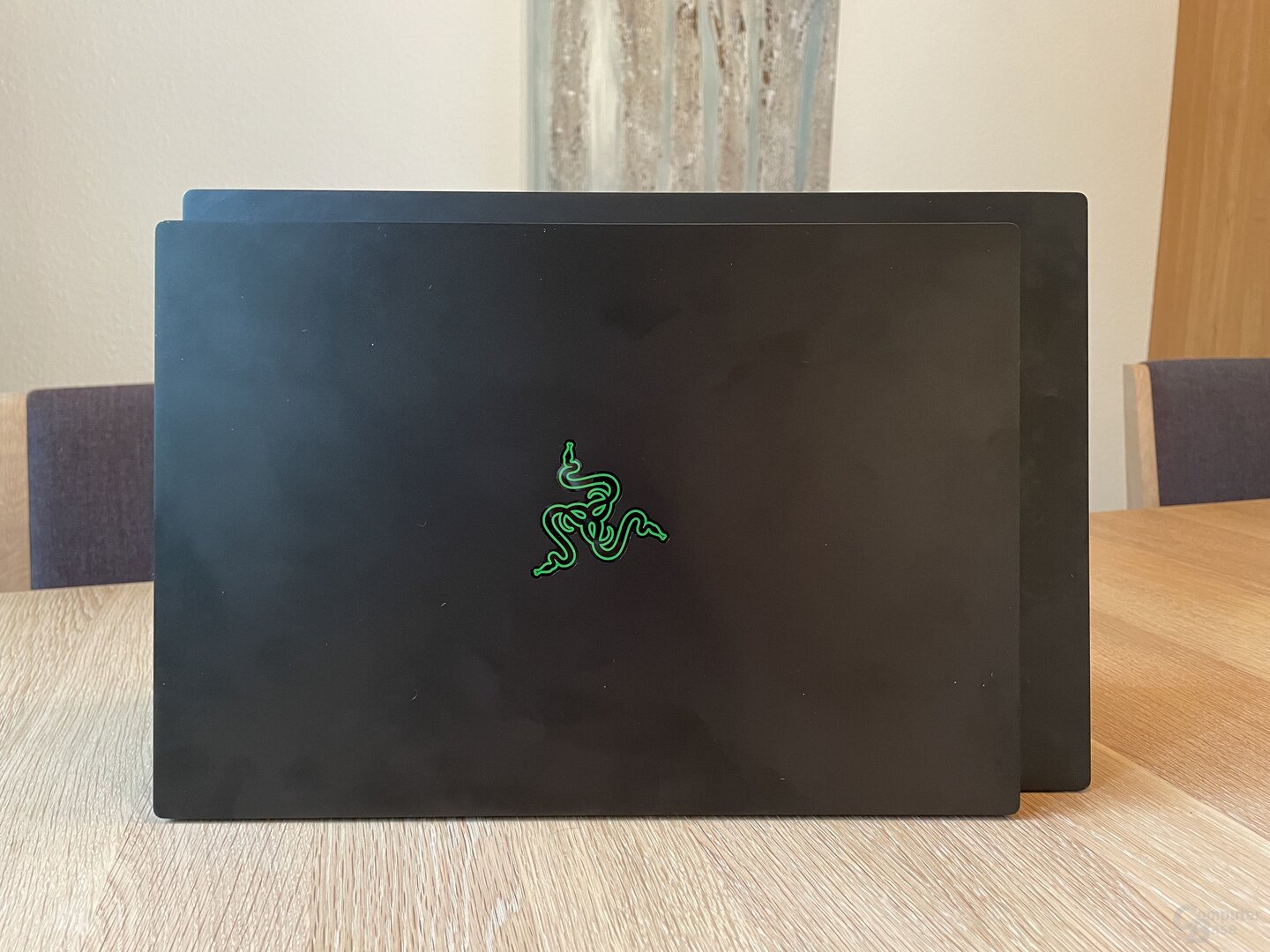Three years ago, Razer dumped the Blade 14; the Blade 15 promised more performance and the advantages of a 15.6-inch display in the hardly larger chassis. Now the Razer Blade 14 is returning in a very special way: For the first time, the manufacturer is relying on AMD CPUs. The test clarifies what the new model can do.
Table of contents
- 1 Ryzen with 75 and GeForce RTX with 100 W in the smallest of spaces
- The new Razer Blade 14 with AMD Ryzen
- AMD Ryzen 9 5900HX with permanently up to 70 watts
- Nvidia GeForce RTX 3060 laptop GPU with a maximum of 100 watts
- Two fast displays with FreeSync to choose from
- Always with you 16 GB RAM and 1 TB SSD
- Technical specifications at a glance
- 2 test results
- A few words about notebook benchmarks
- Classification in old test results
- Benchmarks in Full HD
- Benchmarks in WQHD
- Benchmarks with ray tracing
- CPU- Benchmarks with Ryzen 9 5900HX
- 3 Conclusion
The new Razer Blade 14 with AMD Ryzen
The manufacturer justifies the resurrection of the Razer Blade 14 on the one hand with the possibility of being able to offer such a gaming notebook in the footprint of a 13-inch model nowadays, on the other hand, that of 15-inch notebooks will be 30 Percent of shrunk chassis listed realizable performance. 14-inch gaming devices could simply offer gamers more than ever before, so the category makes more sense than ever. And what exactly does Razer offer in the Blade 14?
AMD Ryzen 9 5900HX with permanently up to 70 watts
First of all, a lot of CPU power. The mobile Ryzen 9 5900HX (test) always provides this in the new Blade 14. Depending on the profile selected in Razer Synapse, the Zen 3 processor with eight cores can officially consume up to 65 watts for a short time and up to 54 watts permanently. In the “balanced” profile, which is active ex works, it is 42 and 35 watts, respectively. The manufacturer has recently revealed this at the introduction. For years, however, Razer did not provide this information even when asked. The decision to actually do it now is a welcome step.
 The profiles in Razer Synapse 3
The profiles in Razer Synapse 3 The CPU does more as promised
The test to the example even shows that the Blade 14 even surpasses the official specifications. In the “Boost” CPU profile, not only 65, but 70 watts are permanently available; in the “Balanced” profile, it is 42 watts permanently and not for a short time. The Ryzen 9 5900HX in the compact Razer Blade 14 can be driven up to 25 watts compared to the Ryzen 9 5900HX in the Asus ROG Strix G15, which is operated with an almost insane 95 watts. In the Blender benchmark, both CPUs only separate 130 MHz on average over the runtime.
There is also a difference between the two notebooks in the single-core run of the Cinebench R20, which the Ryzen 9 5900HX in the Blade 15 completed with around 20 watts, regardless of the profile, while in the Asus ROG Strix G15 it performed with around 5 watts more: 60 MHz the processor of the same type in the Asus notebook achieves more in this way. But it's also lightning fast in the Razer Blade 14.
«Previous Package Power (Blender, BMW) Clock (Blender, BMW) CPU temperature (Blender, BMW) Package power (CB R20 SC) Clock (CB R20 SC ) CPU temperature (CB R20 SC) Next »
- Package Power (Blender, BMW) 024487296120Watt (W) 171,31925313743495561677379859197103109115121127133139145150 Ryzen 7 4800U, 20W (Yoga Slim 7) Ryzen 7 4800U, 38W (Yoga Slim 7) XM7-10870H, 55/135870 (Core i7-10870H, 55/135870) 45/90W (XMG Pro 17) Ryzen 7 5800H, 45/65W (XMG Core 17) Ryzen 7 5800H, 80/95W (XMG Core 17) Ryzen 9 5980HS, 80/130 W (ROG Flow X13) Ryzen 9 5980HS, 42/65 W (ROG Flow X13) Ryzen 9 5980HS, 35/65 W (ROG Flow X13) Ryzen 9 5900HX 95/107 W (ROG Strix G15) Ryzen 9 5900HX 70/78 W (Blade 14) Ryzen 9 5900HX 42/56 W (Blade 14)
- Clock (Blender, BMW) 01.0002.0003.0004.0005.000MHz 17131925313743495561677379859197103109115121127133139145150 Ryzen 7 4800U, 20W (Yoga Slim 7) Ryzen 7 4800U, 38W (Yoga Slim 7) Core i7-10870H, 557/135870H X , 45/90W (XMG Pro 17) Ryzen 7 5800H, 45/65W (XMG Core 17) Ryzen 7 5800H, 80/95W (XMG Core 17) Ryzen 9 5980HS, 80/130 W (ROG Flow X13) Ryzen 9 5980HS, 42/65 W (ROG Flow X13) Ryzen 9 5980HS, 35/65 W (ROG Flow X13) Ryzen 9 5900HX 95/107 W (ROG Strix G15) Ryzen 9 5900HX 70/78 W (Blade 14) Ryzen 9 5900HX 42/56 W (Blade 14)
- CPU temperature (Blender, BMW) 024487296 120 ° C 17131925313743495561677379859197103109115121127133139145150 Ryzen 7 4800U, 20W (Yoga Slim 7) Ryzen 7 4800U, 38W (Yoga Slim 7) Core i7-10870H, 55/1358W (X, Core i7-10870H, 55/1358W) 45/90W (XMG Pro 17) Ryzen 7 5800H, 45/65W (XMG Core 17) Ryzen 7 5800H, 80/95W (XMG Core 17) Ryzen 9 5980HS, 80/130 W (ROG Flow X13) Ryzen 9 5980HS, 42/65 W (ROG Flow X13) Ryzen 9 5980HS, 35/65 W (ROG Flow X13) Ryzen 9 5900HX 95/107 W (ROG Strix G15) Ryzen 9 5900HX 70/78 W (Blade 14) Ryzen 9 5900HX 42/56 W (Blade 14)
- Package Power (CB R20 SC) 01020304050Watt (W) 114274053667992105118131144157170183196209222235248261274287300313326339350 Ryzen 7 4800U, 20W (Yoga Slim 7) Ryzen 7 4800U, 38W (Yoga Slim 7) Core i7-10870H, XM7/135 1770H , 45/90W (XMG Pro 17) Core i7-1185G7, 36W (Whitebook) Core i7-1185G7, 15W (Whitebook) Core i7-1165G7, 15W (Swift 3) Core i7-11370H, 64W (TUF 15) Ryzen 7 5800H , 45/65W (XMG Core 17) Ryzen 7 5800H, 80/95W (XMG Core 17) Ryzen 9 5980HS, 80/130 W (ROG Flow X13) Ryzen 9 5980HS, 42/65 W (ROG Flow X13) Ryzen 9 5980HS , 35/65 W (ROG Flow X13) Ryzen 9 5900HX 95/107 W (ROG Strix G15) Ryzen 9 5900HX 70/78 W (Blade 14) Ryzen 9 5900HX 42/56 W (Blade 14)
< li class = "js-chart-carousel-li nojs-block" role = "presentation" hidden>CPU temperature (CB R20 SC) 01836547 290 ° C 114274053667992105118131144157170183196209222235248261274287300313326339350 Core i7-10870H, 55/135W (XMG Pro 17) Core i7-10870H, 45/90W (XMG 7 65W Pro 17) Ryzen 7 5800H, 80/95W (XMG Core 17) Ryzen 9 5980HS, 80/130 W (ROG Flow X13) Ryzen 9 5980HS, 42/65 W (ROG Flow X13) Ryzen 9 5980HS, 35/65 W (ROG Flow X13 ) Ryzen 9 5900HX 95/107 W (ROG Strix G15) Ryzen 9 5900HX 70/78 W (Blade 14) Ryzen 9 5900HX 42/56 W (Blade 14)
With regard to the CPU, it is also interesting to look at the temperatures: In the “Boost” profile, Razer not only allows a lot of TDP at high volume (44 decibels at a distance of 40 cm), the CPU temperature is also with a target value of 100 ° C high. The sum of these measures makes the extremely high CPU performance of the Razer Blade 14 possible despite the small chassis volume.
Nvidia GeForce RTX 3060 laptop GPU with a maximum of 100 watts
The power dissipation of the built-in GPUs, customers have the choice between GeForce RTX 3080 laptop GPU (8 GB), RTX 3070 laptop GPU (8 GB) and the RTX 3060 laptop GPU (6 GB) built into the test sample, Razer not only gives – how prescribed by Nvidia – with the respective maximum, but also for each profile. As a result, the mobile dGPU can be operated with 80 + 10 watts or 90 + 10 watts (TGP + Dynamic Boost 2.0) and thus with a maximum of 100 watts, regardless of the selected class. That is 30 watts less than Nvidia allows for the mobile 3060, 40 watts less than the maximum allowed for the mobile 3070 and 65 watts less than the largest mobile 3080 – the larger the class, the further the built-in GPU is from the maximum performance .
According to Razer, that's not the point. Rather, the manufacturer points out: So far there is a maximum of one GeForce RTX 3060 laptop GPU in 14-inch notebooks on the market, but the Acer Triton 300 SE only operates with 75 watts and only with a 4-core CPU of the type Tiger Lake-H35 (test) is combined. As a result, the new Razer Blade should really be the fastest gaming notebook of its kind, as advertised by the manufacturer.
Be careful, don't be blinded
Buyers of the Razer Blade 14 should also be aware that between the GeForce RTX 3060 and GeForce RTX 3080 with the same TGP in games there are only minor differences in performance, and in Full HD there are usually no differences at all. The editorial team “only” had the model with 3060 available, but reaching for the 3080 can also be called “remotely” as absolutely unnecessary, because it does not provide much more performance than the 3070 even in the GPU limit and offers 8 GB both. The 3060 only has 6 GB of memory.
90 + 10 watts are held permanently
With regard to the GPU, the test confirms that of Razer made statements: Permanently up to 100 watts are in the “high” profile, permanently up to 90 watts in all other profiles. In Doom Eternal (UHD) this results in approx. 210 MHz or 15 percent higher clock rates.
«Previous GPU power consumption (Doom) GPU clock (Doom) GPU temperature (Doom) Next»
- GPU power consumption (Doom) 04080120160200Watt (W) 15913172125293337414549535761656973778185899397100Seconds low/low balanced high/high = “js. class =” js -chart-carousel-li nojs-block “role =” presentation “hidden> GPU clock (Doom) 04008001.2001.6002.000MHz 15913172125293337414549535761656973778185899397100Seconds low/low balanced high/high
- GPU Temperature (Doom) 5060708090 100 ° C 15913172125293337414549535761656973778185899397100Seconds Low/Low Balanced High/High
–
The higher output with only 10 watts more power consumption is accompanied by a significantly higher background noise: Instead of 37 decibels in the “Low/Low” and “Balanced” (“Auto”) profiles, there are 44 decibels 40 cm in front of the display (identical to the CPU -Full load in the “Boost” profile). In addition to the higher power consumption, the target temperature also contributes to this: In the “high/high” profile, it is slightly below and not 70 ° C.
Volume according to profiles (Doom) Unit: dB (A)
-
- Hoch/Hoch44,0
- Low/Low37.0
- Balanced37.0
Two fast displays with FreeSync to choose from
Gamers have two displays to choose from with the Razer Blade 14: A Full HD model with 144 Hz and 100 percent coverage of the sRGB color space and a QHD display with 165 Hz and 100 percent coverage in the DCI-P3 color space – the QHD Variant is the first 14-inch model with more than 60 Hz on the market. Both support AMD FreeSync and are, according to Razer, “on IPS level”. Customers only have a limited choice: FHD is available with the GeForce RTX 3060 laptop GPU, QHD with GeForce RTX 3070 laptop GPU or GeForce RTX 3080 laptop GPU.
The Full HD display in the test sample with GeForce RTX 3060 laptop GPU is visibly brighter with up to 373 cd/m² and an average of 350 cd/m² than, for example, the screen in the Asus ROG Strix G15 with Radeon RX 6800M (test) Editorial staff had recently inspected. The homogeneity of the illumination is at a high level with a maximum deviation of 10 percent. At around 1,300: 1, the contrast is also slightly higher than that of the Asus device.
 Razer Blade 14: FHD display homogeneity
Razer Blade 14: FHD display homogeneity “Vari-Bright” is active ex works in Radeon Settings for 2D rendering on the desktop, which reduces the display brightness the more the darker the screen content is. If that bothers you, you can deactivate the function in the driver. You can also switch between 60 and 144 Hz on the display directly in Razer Synapse.
Additional external displays can be connected to the notebook via one HDMI 2.1 and two DisplayPort 1.4 via alternate mode of the two USB Type-C ports. In addition to the aforementioned two USB-C 3.2 Gen 2 (10 Gbit/s) including 100 watt power delivery, there are also two USB-A 3.2 Gen 2 sockets and a 3.5 mm jack connection as well as Razer's proprietary charging connection in the chassis again.
Always with 16 GB RAM and 1 TB SSD
Regardless of the configuration, Razer always delivers the Blade 14 (2021) with soldered 16 GB DDR4-3200; there is no option for 32 GB in this series. The memory runs with CL22 with relatively conservative timing, in the test of the Radeon RX 6800M the editors have already addressed the issue of memory a little src = “/wp-content/uploads/8755a4ca7805cb24dd21064bf6c5b56e.jpg” /> Timings Razer Blade 14
There is also no choice for the SSD: An M.2 NVMe model with 1 TB of storage is set. The test system is based on the Samsung PM981a, the quasi-OEM version of the Samsung SSD 970 Evo for PCI Express 3.0 with a Phoenix controller. Because the Ryzen 5000 does not offer PCI Express in the notebook, the drive is an appropriate choice. Razer does not guarantee that this SSD is in every Blade 14.
 The SSD in the Razer Blade 14: Samsung PM981a
The SSD in the Razer Blade 14: Samsung PM981a 
The battery is always 61.6 Wh and should enable twelve hours of runtime – no notebook from the manufacturer can currently last longer, promises Razer. WiFi 6, Bluetooth 5.2, a webcam with Windows Hello support and the illuminated keyboard (RGB) are also standard. The cooling is based on a large vapor chamber on the CPU and GPU, the heat that is dissipated this way is carried out of the case by two fans.
Technical specifications at a glance
The final table contains an overview of the technical data for the Razer Blade 14 . After the Asus ROG Strix G15 did not offer a webcam as a gaming notebook, the Razer Blade 14 needs to be pointed out that the built-in model is even compatible with Windows Hello in this case and enables Windows 10 to be unlocked with the face.
 The Razer Blade 14 in front of the Razer Blade 15
The Razer Blade 14 in front of the Razer Blade 15 6 GB , up to 90 + 10 watt GeForce RTX 3070 laptop GPU
8 GB, up to 90 + 10 watt GeForce RTX 3080 laptop GPU
8 GB, up to 90 + 10 watt display FHD, 144 Hz, 100% sRGB , FreeSync QHD, 165 Hz, 100% DCI-P3, FreeSync RAM 16 GB DDR4-3200 (soldered) SSD 1 TB NVMe (M.2) Connections 2 × USB 3.2 Gen 2 Type C (incl.DP 1.4, 100 Watt)
2 × USB 3.2 Gen2 type A, 1 HDMI 2.1,
1 × headphone/microphone output,
power connection wireless network WiFi 6, BT 5.2 Dimensions (W × D × H) 320 × 220 × 16.8 mm Weight 1.78 kg Battery 61.6 Wh Operating system Windows 10 Home Price 1,999.99 euros 2,399.99 euros 2,999.99 euros
On the next n page: Test results